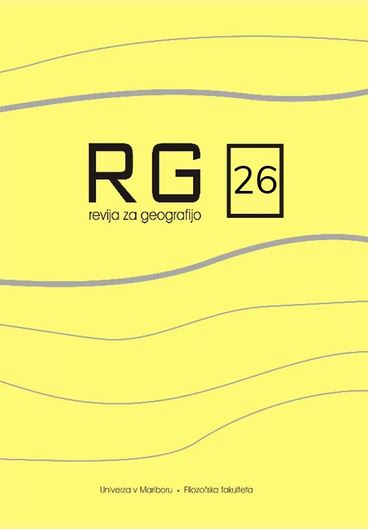Natality effects on the elementary school population in Tuzla Canton
DOI:
https://doi.org/10.18690/rg.13.2.3721Keywords:
Tuzla Canton, elementary school population, natality, aging, emigrationAbstract
The end of the 20th and the beginning of the 21st century in the area of Tuzla Canton is characterized by negative demographic trends such as decreasing birth rates, increasing mortality rates, decreasing natural change rates, aging population, decreasing total population, while adverse economic, social, political and other conditions after 1995 intensified economic emigration, mainly in the population between 20 and 40 years of age. As a result of such demographic trends, the aging process of the population has intensified in the post-war period, and this demographic process reverses the decline in potential biodynamics and population vitality. Due to the negative demographic trends in this area there has been a decrease in the population of elementary school age. The aim of this paper is to identify the main factors influencing this reduction, as well as the degree of their impact on this process, with particular emphasis on the natural dynamics of the population and the intensive population emigration. If no appropriate population policy activities are taken in the future, negative demographic trends may become even more expressed, which could adversely affect primary education in the municipalities of Tuzla Canton.
Downloads
References
Analiza uzroka nepohađanja, napuštanja i smanjenja broja učenika u osnovnim školama u Federaciji Bosne i Hercegovine. Federalno ministarstvo obrazovanja i nauke (FMON). Mostar, 2013.
Census of Population, Households and Dwellings in Bosnia and Herzegovina 2013. Agency for Statistics of Bosnia and Herzegovina (BHAS). Sarajevo.
Federal Administration for Geodetic and Property Affairs. Sarajevo, 2018.
First Release No. 2., Year XII, 2018 and First Release No. 1, Year III, 2008. Agency for statistics of Bosnia and Herzegovina. Sarajevo.
First Release No. 8.1.2., Year LV, 2018 and First Release No. 8.1.2., Year XLV, 2008. Croatian Bureau of Statistics. Zagreb.
First Release No. 75, Year LXVII, 2017 and First Release No. 86, Year LVII, 2007. Statistical Office of the Republic of Serbia. Belgrade.
First Release No. 12.1, Year VIII, 2016. Institute for Statistics of FBiH (FZS), Sarajevo.
Gelo, J. 2004: Kretanje broja rezidencijalnog (boravećeg) stanovništva Hrvatske u 20. stoljeću. Društvena istraživanja, Godina 13, Broj 4-5. Zagreb.
Hospers, G-J., Reverda, N. 2015: Managing Population Decline in Europe`s Urban and Rural Areas. SpringerBriefs in Population Studies. https://doi.org/10.1007/978-3-319-12412-4_6
Informacija o upisu učenika u osnovne i srednje škole u školskoj 2017/18. godini u Federaciji Bosne i Hercegovine. Federalno ministarstvo obrazovanja i nauke (FMON). Mostar, 2017.
Informacija o upisu učenika u osnovne i srednje škole u školskoj 2012/13. godini u Federaciji Bosne i Hercegovine. Federalno ministarstvo obrazovanja i nauke (FMON). Mostar, 2012.
Izvještaj o radu u 2005. godini. Ministarstvo obrazovanja, nauke, kulture i sporta Tuzlanskog kantona (MONKSTK). Tuzla, 2005.
Kadušić, A., Suljić, A., Smajić, N. 2016: The Demographic Ageing of Population in Bosnia and Herzegovina - Causes and Consequences. Revija za geografijo - Journal for Geography, 11-1. Maribor.
Longley, P., Goodchild, M., Maguire, D., Rhind, D. 2005: Geographic Information Systems and Science. John Whiley & Sons, Ltd.
McCarroll, D. 2016: Simple statistical tests for geography. CRC Press. Boca Raton, Florida.
Muenz, R. 2007: Aging and Demographic Change in European Societies - Main Trends and Alternative Policy Options. SP Discussion Paper No. 0703. Socal Protection, The World Bank. Washington.
Nejašmić, I. 2005: Demogeografija - stanovništvo u prostornim odnosima i procesima. Školska knjiga. Zagreb.
Pallant, J. 2011: SPSS Survival Manual. Allen&Unwin. Crows Nest Australia.
Papić, M. 2008: Primijenjena statistika u MS Excelu. Naklada Zoro. Zagreb.
Population migration 2016, Statistical Bulletin 246. Institute for statistics of Federation BiH (FZS). Sarajevo.
Population migration 2010, Statistical Bulletin 151. Institute for statistics of Federation BiH (FZS). Sarajevo.
Rogerson, P. 2001: Statistical methods for Geography. Sage Publications. Trowbridge Wiltshire.
Statistical Yearbook 2017. Institute for statistics of Federation BiH (FZS). Sarajevo.
Statistical Yearbook 2007. Institute for statistics of Federation BiH (FZS). Sarajevo.
Stojković, M. 1998: Statistički metodi u turizmu. Institut za geografiju. Novi Sad.
Tuzla Canton in numbers 2017. Institute for statistics of Federation BiH (FZS). Sarajevo.
Zakon o socijalnoj zaštiti, zaštiti civilnih žrtava rata i zaštiti porodice s djecom. Službene novine TK, br. 12, 2000.
